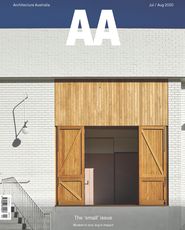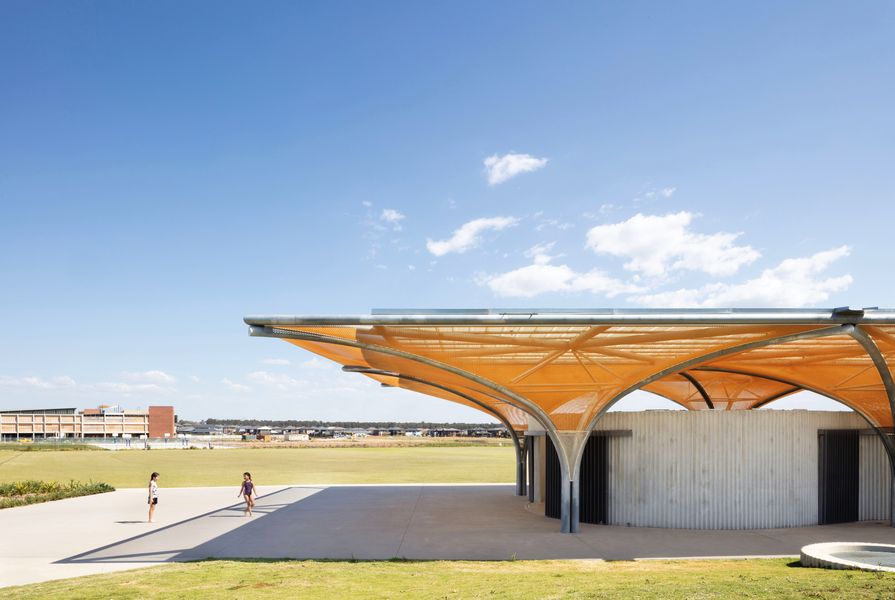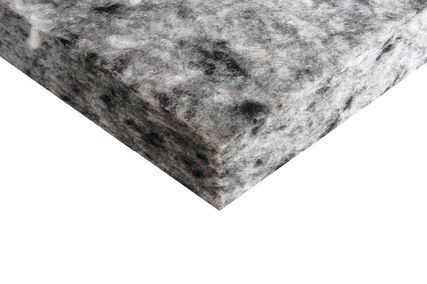I first visited Marsden Park on a Saturday morning during the early weeks of COVID-19 and social distancing. The newly established suburb in Sydney’s north-west felt still, the front yards unoccupied, curtains drawn, no one meandering about, not even cars. A generously scaled green playing field, soon visible on arrival, offered space, light and air amidst the relatively dense subdivision – but it was utterly bare, without weekend sport, games or playing kids. It was as if the necessary retreat from public life had heightened the sense of newness, the just-finished quality of this young neighbourhood unaltered by use, age or patina. And yet, despite this eerie sense of quiet vacancy, the dynamic, glowing figure of the Marsden Park Amenities, at the entryway to the oval, appeared unreservedly buoyant, waiting for – encouraging – occupation: come in, come in. If works of architecture can invoke a sense of optimism, and for me they certainly can, then this whimsical suburban infrastructure by Chrofi feels utterly big-hearted and infused with a sense of hope and generosity.
Between the enclosed areas, void spaces define shaded rooms and passages, includng a central chamber and a wide rim to stepped seating.
Image: Clinton Weaver
The project was conceived in response to a limited architectural competition coordinated by landscape architects JMD Design on behalf of Stockland, the private developers for the site. With the start of construction imminent, the amenities building was proposed as a small but substantial ingredient within a planned suburb that, when complete, would support around 6,000 residents, 2,200 dwellings, two schools and two sports fields as well as smaller parks and community facilities. Located along an east–west tree-lined “collector road” – the main vehicular axis to the precinct – the squarish playing field was designed as a dominant figure within a mixed-use urban envelope constituting a community and commercial zoning to the west, an independent school to the north and residential blocks to the south and east. The sports oval was, in effect, presented as a public square, a town centre.
JMD’s early landscape proposal informed the competition brief. Communicated via a concept plan for the oval and its surrounds, a constellation of landscape and play elements – composed in an L-shaped sequence – embraced the oval to the north and east, deftly integrating two sizable carparks at the limits of this leisure-scape. To the north, at the threshold between the field and the road, a rectangular diagram outlined the amenities building envelope, loosely proposing a platform and overhead canopy with service rooms, toilets, change rooms and the like nested beneath. Immediately adjacent, an arbour extended the pavilion form toward the north-east corner, where a cluster of trees marked a gateway to the field. In this landscape strategy, the amenity building was proposed as essential to the entry sequence, with the potential to announce the playing field and the surrounding township. Chrofi’s architectural response amplifies this very possibility.
Seen from inside, the singular roof form fragments from a figural whole into a mesmerizing atmospheric pattern.
Image: Clinton Weaver
A bespoke architectural figure, legible and image-able, or an infrastructural field, organizational and systematic? The Marsden Park Amenities project is both. Two core strategies were explicit in Chrofi’s response from the outset. First, and taking a cue from JMD’s coupling of the pavilion and the arbour, the architect combined the two as a single integrated system: a light, spatialized green roof over a generous podium with service capsules within. Second, and through the testing of multiple iterations, the spatial system was resolved as a grove of vaulted steel ribs and taut mesh membrane, capped by an improbably thin, translucent, flat roof that projected out – floating – over cantilevered diagonal half-arches. The impression was of practical utilities suspended within the lofty figure of a dematerialized gothic hall, overgrown with foliage.
Chrofi’s competition bid was grounded in a relevant track record, including the amenities and shade structures at Ballast Point (2009, for Sydney Harbour Foreshore Authority), Port Botany (2009, for the Port Authority of New South Wales) and Lizard Log (2012, with McGregor Coxall, for Western Sydney Parklands Trust). In the decade or so since these early achievements, Chrofi has galvanized its reputation as one of Sydney’s most diverse and vibrant architectural practices. (We might say that it is now well and truly established!) And, over a similar period, the designer loo – once a distinctly inner-Sydney phenomenon – has matured as a contained yet effective commission type with tangible impact. In an eloquent 2017 review on ArchitectureAU, Andy Fergus tracks the trajectory of architect-designed amenities buildings, highlighting the City of Sydney’s progressive procurement processes as the early impetus behind their proliferation. 1 This approach, deployed in a similar fashion by a variety of public trusts and state and local authorities, engaged promising young practices for small-scale civic commissions that helped shape the public realm, sponsoring diversity while mitigating risk. Architecture was here called on to both support culture and materialize governance.
The orange mesh stretched across the roof, “at once material and ethereal,” is reminiscent of the shadecloth so familiar in public parks.
Image: Clinton Weaver
Notwithstanding the contextual sensitivity embodied by this architectural series, a shared impulse was to recast the introverted post-war toilet block into a porous envelope, permeated by light and air, with a sense of security and prospect. The inherent opportunity at these sites, typically located in public parks or landscape settings, was to interlace the architecture with its immediate environment.
Chrofi’s early response at both Port Botany and Ballast Point resolved the program as discrete architectural elements: a flat roof suspended over a grounded platform as the substructure, within which rooms and voids were dispersed. At Lizard Log, the evolution of this approach was transported to Western Sydney Parklands, at the outer metropolitan limits; now at Marsden Park, further north-west, it has reached Sydney’s outer suburban fringe. As Fergus observes, the migration of the designer loo from the urban centre to the periphery is a welcome investment in architecture in regions typically bereft of such bespoke attention. That this investment now finds patrons in the private sector attests to the capacity of these contained works to punch far above their weight, not only to sustain but to elevate community participation. For Chrofi, the return to this programmatic type at Marsden Park presented the opportunity to explore the expressive potential of such a micro-civic injection.
Chrofi has recast the introverted post-war facilities block into a light, airy structure that interlaces with the surrounding landscape.
Image: Clinton Weaver
The completed pavilion rests effortlessly in its location, gently curved to address the field, seamlessly integrated with the subtly sculpted landforms: a grass mound at the street, an elegant line of cascading steps at the field boundary. In between the architectural enclosures, void spaces, outlined by structural lines and planes, define shaded rooms and passages – a central chamber for mingling and weekend barbecues, a walkway parallel to the sidewalk, a wide rim to the stepped seating. The material finish and juxtapositions are deftly calibrated. The proposed green roof is now abstracted, the planned live foliage replaced by luminous bubbles of light and air. A soft, rusty orange mesh, stretched taut between the galvanized metal structure, represents the shadecloth so familiar at public parks as a vaulted, transparent surface, at once material and ethereal. And when viewed from within the kiosk, change rooms or toilets, the singular roof form fragments until it is no longer a figural whole but a mesmerizing atmospheric pattern. Walking below the glowing canopy, in among the voluptuous, softly corrugated profiles of concrete pods, it was heartening to imagine a return of play to this spirited place where infrastructure, structure, landscape and theatre interweave as marvellous local shelter.
1. Andy Fergus, “Designer public dunnies: Civic dignity in small public architecture,” ArchitectureAU, 23 August 2017, architectureau.com/articles/designer-public-dunnies-civic-dignity-in-small-public-works/ (accessed 18 May 2020).
Credits
- Project
- Marsden Park Amenities
- Architect
- CHROFI
Sydney, NSW, Australia
- Project Team
- John Choi, Eoin Healy, Alberto Quizon
- Consultants
-
Access consultant
Accessible Building Solutions
Architectural mesh Kaynemaile
BCA consultant Advance Building Approvals
Canopy cladding Fleetwood Urban
Hydraulic engineer ITM Design
Landscape architect JMD Design
Lighting and electrical engineers LAAS
Project manager Loganwater Projects
Quantity surveyor Hollis Partners
Steel fabricator Apollo Fabrication
Structural engineer SDA Engineering
- Aboriginal Nation
- Marsden Park Amenities is built on the land of the Darug people.
- Site Details
-
Location
Sydney,
NSW,
Australia
- Project Details
-
Status
Built
Completion date 2019
Category Public / cultural
Type Amenities
Source

Project
Published online: 19 Oct 2020
Words:
Maryam Gusheh
Images:
Clinton Weaver
Issue
Architecture Australia, July 2020

























